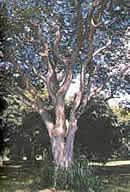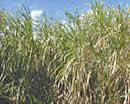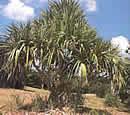Tropical Caribbean Plants
The Tropical Forests
Our forests contain abundant wealth for nature lovers, soils covered by creepers as the burr, an endless species of mauve that account for a high percentage of spontaneous vegetation, fern varieties and some thousand species of cacti, bush and arborescent plants which are the most typical and exotic samples of our landscapes, especially in Mexico.
Lianas, creepers are weaving the forest thick structure and contribute to its diversity and usefulness; for example, the Christmas flower or garland, widely spread in the tropical Americas, creeps on fences, shrubs and tall trees, blossoming from November to February as if greeting Nature and Christmas celebrations.
Many species of tall trees create in some regions the humid and dark atmosphere which operates like a weather stabilizer and offers the ideal habitat to the fauna varieties of the Caribbean region. The ácana and its different species: guásima; jagua; cedar, a part of the indigenous flora of all Latin-American countries and whose fragrant wood is of great demand in the world wood markets; the majagua, sabicú, guayacan or palo santo, jocuma, mastic tree, yagruma, júcaro, the latter endowed with an unspoiled wood; the Cuban pine from the Caribbean, cabo de hacha and its sister, the siguaraya, one of the best nectariferous species of the tropics, are just some of the samples of the trees found in the region which supply the treasure of their woods for multiple uses. Leaves, barks, flowers and resins are used in the elaboration of some medicinal and cosmetics products; dyes or paintings and extracts of several industrial applications.
The Antillean Mahogany Tree in El Escorial
Large amounts of mahogany were shipped between 1563 and 1584 and used in the building of El Escorial Palace in Spain and then in the construction of the Royal Spanish Armada and in the furniture of many European palaces; but the oldest items made of mahogany which have survived the passing of time are found in the Cathedral of Santo Domingo in the Dominican Republic.
Ceiba: Sacred, Majestic and Invincible
The imposing ceiba, though it also grows in other regions, is one of the tallest trees and more characteristic of the tropical America. Its growth is slow, may last centuries and take several years to blossom and reaches a height of 40 m and its diameter is such that ten men around the tree with their arms wide open, taking the hands of one another are not enough to measure it. It is regarded as a sacred tree in Cuba.
The main product taken from this legendary tree is the wool or cotton surrounding their seeds; “kapok” is the name by which is traded and is used to stuff mattresses, pillows, cushions and other articles.
Four Protagonists: Coffee, Sugar Cane, Cacao and Cigar
Coffee: The coffee tree was brought in the 18th century from Martinique where the crop developed, blossomed and multiplied; little by little the seedlings were transferred from this country to Santo Domingo, Guadeloupe and other islands of the Caribbean. Later the crop was introduced by the Dutch in the Guianas and then in Brazil, which is currently the largest world producing country. Large amounts of coffee are also produced in Colombia. Other countries of the area contribute with their harvests, along with the southern giant, to the fact that four-fifth of the coffee of the world are produced in the Americas.
Sugar Cane. It is stated that in the year 755 BC, sugar cane was cultivated in the region of Andalusia. On his second voyage (1493) Christopher Columbus brought this crop to the Americas, to the Hispaniola (today the Dominican Republic) from there Diego Velázquez transferred it to Cuba during the first years of his government. As a result, the Antillean island over time became the first world sugar exporter.
Cacao. Cacao tree is native of the northern area of South America where it grows wild in some spots. From the fruit of the cacao tree, cocoa and commercial chocolate are obtained, this is the reason why this tree is widely cultivated in the tropics. The main producing countries are Brazil, Venezuela, Ecuador and the Dominican Republic; it is also cultivated in Mexico, Costa Rica, Panama, Haiti, Cuba and Trinidad. The list of various kinds of confectionery, ice creams, sweets, liquors and other food products that can be elaborated from cocoa as the basic ingredient is fairly long.
Tobacco. It is a native plant of South America. It was probably used by American aborigines as a stimulating beverage for thousand years. Few days later after the discovery of the Americas, the Spaniards learnt the use of tobacco with these first settlers.
The Cuban cigar has been recognized and regarded as the best of the world. The selection for the ideal lands for tobacco plantations, the genetic upgrading welcomed by this crop and the enrooted tradition of the cigar industry have contributed to the unequal quality of this item.
Other Stimulating Plants
Maté is an American plant whose leaves are used as tea. It is a medicinal beverage for the stomach, stimulating as well as nutritional and is also the favorite tea of the Argentineans. Pulque and mezcal, very popular liquors in Mexico, are elaborated from the maguey tree. Other plants grow in the Antilles and Central America which are highly cherished varieties for the fibers taken from their leaves, as is the case of sisal.
The Edible Vegetables
In reference to the edible vegetables extensively cultivated in the tropical Caribbean, mention will be made just to those planted by the aborigines such as cassava, sweet potato, corn, beans, pepper, peanut and pumpkin, in addition to a large number of fruits. Of them all, only cassava and corn have been extensively cultivated.
The Green Lungs of the City
The trees, purifying the atmosphere and attenuating dust and noise with their indispensable presence in the Caribbean landscape, are in fact the green and fragrant lungs of the cities. Tall laurels, almond trees, carob trees, ocujes, júcaros, jagueyes, flame trees and several varieties of palm trees provide their shade in avenues, parks and roads.
S.O.S.
Desertification threatens today the third part of the surface of the Earth. To protect and love trees is to safeguard the present life and the future generations. We should embrace this world ecological principle: We have not inherited this land from our fathers; instead, we have borrowed it from our children.












































































